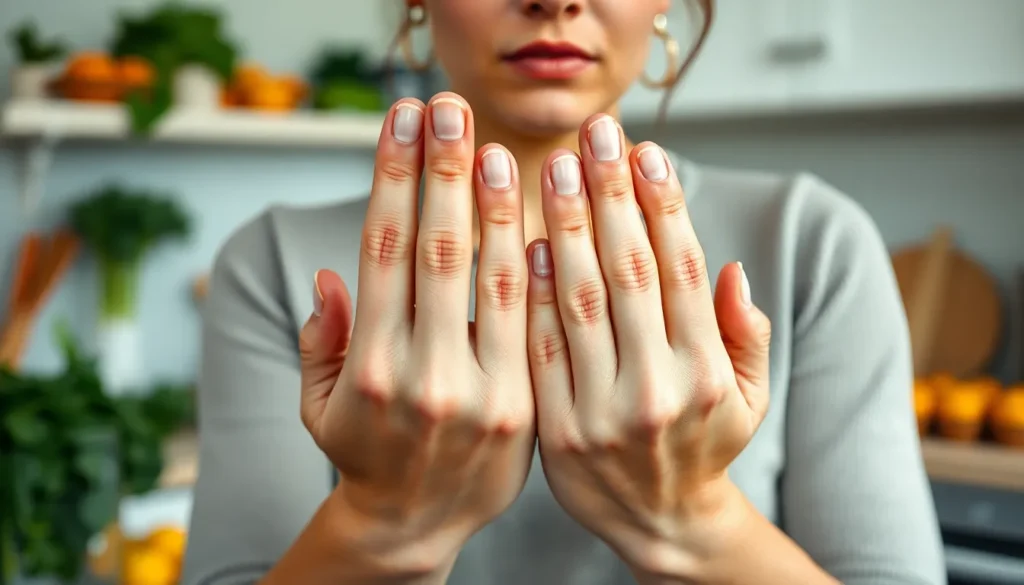Table of Contents
TogglePeeling skin on fingers might seem like a minor annoyance, but it could be your body’s way of sending an SOS. Imagine your skin throwing a tantrum because it’s missing key vitamins. It’s not just a fashion faux pas; it could signal a deeper issue.
Picture this: you’re trying to impress at a dinner party, but your fingers look like they just survived a rough battle with a sandpaper factory. Not exactly the first impression anyone hopes to make. Understanding the link between vitamin deficiencies and peeling skin can save you from the awkwardness and help you flaunt healthy, happy hands.
Understanding Peeling Skin on Fingers
Peeling skin on fingers often signals underlying vitamin deficiencies. Recognizing its causes and symptoms helps identify appropriate treatments and promote skin health.
Causes of Peeling Skin
Vitamin deficiencies lead to peeling skin on fingers, particularly deficiencies in B vitamins, vitamin C, and vitamin E. A deficiency in B6 can affect skin health, causing dryness and peeling. Insufficient vitamin C affects collagen production, leading to flaky skin. Low levels of vitamin E can decrease skin hydration, resulting in brittleness. Other causes include environmental factors like dry air and excessive handwashing, both of which strip moisture from the skin. Skin conditions, including eczema and psoriasis, also contribute to peeling.
Symptoms to Watch For
Identifying accompanying symptoms helps in assessing the severity of peeling skin. Cracked or painful skin often accompanies peeling fingers. Redness and inflammation can indicate inflammation or infection. Also, persistent peeling might point to a chronic condition rather than a temporary issue. Observations may include stinging or burning sensations, which signal irritation. If peeling is severe or prolonged, consulting a healthcare professional can provide guidance on necessary interventions and evaluations.
Role of Vitamins in Skin Health


Vitamins play a critical role in maintaining healthy skin. Recognizing the right vitamins contributes to skin repair and restoration.
Essential Vitamins for Skin Maintenance
B vitamins like B1, B2, B3, and B7 support skin cell regeneration and hydration. Vitamin C promotes collagen production and protects against UV damage. Vitamin E functions as an antioxidant, safeguarding skin from oxidative stress. Incorporating these vitamins in a balanced diet enhances skin healing and overall appearance.
How Vitamin Deficiencies Affect Skin
Deficiencies in essential vitamins lead to various skin issues. Low levels of B vitamins may cause dryness and peeling, while inadequate vitamin C can hinder wound healing. Lack of vitamin E contributes to skin’s vulnerability to environmental damage. These deficiencies manifest as red, flaky patches or other signs of irritation. Addressing these shortcomings fosters healthier skin, reducing symptoms like peeling and inflammation.
Common Vitamins Linked to Peeling Skin
Peeling skin on fingers often signals vitamin deficiencies. Understanding the vitamins linked to this symptom aids in identifying underlying health issues.
Vitamin A Deficiency
Vitamin A deficiency leads to dryness and peeling skin. It significantly impacts skin cell production, causing the outer layer to lose moisture. This nutrient plays a crucial role in maintaining skin integrity and prevents excessive shedding. Eating foods rich in retinoids, like carrots and sweet potatoes, supports skin health. A balanced intake ensures skin remains hydrated and resilient, reducing the risk of peeling.
Vitamin B Complex Deficiency
B vitamins are vital for skin health; each plays a unique role. Deficiencies in B1, B2, B3, or B7 can result in peeling or irritated skin. These vitamins support skin cell regeneration and hydration, essential for a healthy barrier. Foods such as nuts, grains, and green leafy vegetables provide necessary B vitamins. Addressing these deficiencies helps to enhance overall skin appearance and reduces flakiness.
Vitamin C Deficiency
Vitamin C deficiency affects collagen production, leading to weak skin. This antioxidant protects against damage from environmental factors, promoting healing. A lack of vitamin C can result in increased dryness and peeling. Citrus fruits and berries are excellent sources of this vitamin. Regular consumption of vitamin C-rich foods strengthens skin and maintains its elasticity.
Vitamin D Deficiency
Vitamin D deficiency can contribute to skin conditions that cause peeling. This vitamin supports immune function, crucial for skin health. Insufficient vitamin D may lead to dry skin without proper healing support. Sun exposure helps produce vitamin D naturally, while fortified foods offer alternatives. Incorporating these sources ensures skin health and minimizes the risk of dryness and peeling.
Vitamin E Deficiency
Vitamin E deficiency can result in increased oxidative stress and skin peeling. This powerful antioxidant protects skin cells from damage and promotes healing. A deficiency may lead to various skin issues, including dryness and irritation. Nuts, seeds, and green vegetables provide ample vitamin E. Prioritizing these foods enhances skin protection and supports overall skin health.
Diagnosing Vitamin Deficiencies
Recognizing vitamin deficiencies involves a combination of clinical assessments and laboratory tests. Identifying these deficiencies can provide clarity on the underlying causes of peeling skin.
Clinical Assessments
Healthcare professionals often start with a thorough clinical assessment. During this evaluation, they review the patient’s medical history and consider lifestyle factors. They may ask about dietary habits and skin care routines. Visual examinations reveal signs of peeling and irritation. Additionally, they assess for associated symptoms like dryness and redness. This holistic approach helps professionals pinpoint potential vitamin deficiencies.
Laboratory Tests
Laboratory tests play a crucial role in diagnosing vitamin deficiencies. Blood tests measure levels of specific vitamins such as B12, vitamin D, and vitamin C. Deficiency indicators in these tests can confirm suspicions raised during clinical assessments. Sometimes, additional tests like skin biopsies may be necessary for a complete evaluation. Results guide healthcare providers in crafting appropriate treatment plans, ensuring that patients receive targeted interventions.
Dietary Sources of Essential Vitamins
Diet plays a key role in providing essential vitamins for maintaining healthy skin. Incorporating specific foods can help address vitamin deficiencies linked to peeling skin on fingers.
Foods Rich in Vitamin A
Carrots offer high levels of vitamin A, which supports skin integrity. Sweet potatoes also contain beneficial beta-carotene, converting to vitamin A in the body. Spinach stands out as another rich source, providing antioxidants that enhance skin texture. Kale contributes to skin hydration and elasticity, thanks to its vitamin A content. Eggs provide a convenient option; the yolk is particularly rich in this crucial nutrient.
Foods High in Vitamin B Complex
Whole grains, such as brown rice and oats, supply B vitamins essential for skin health. Legumes, including lentils and chickpeas, offer a concentrated source of B vitamins like B1, B2, and B3. Nuts, especially almonds and walnuts, provide vitamin B7. Additionally, seeds like sunflower seeds contain B complex vitamins vital for skin regeneration. Animal products such as dairy and eggs are rich in vitamins B12 and B2, supporting overall skin vitality.
Foods Containing Vitamin C
Citrus fruits, such as oranges and grapefruits, are well-known sources of vitamin C, promoting collagen production. Bell peppers, particularly red and yellow varieties, provide substantial vitamin C content, enhancing skin resilience. Strawberries and kiwi are excellent options, known for their high antioxidant levels that protect skin from environmental damage. Broccoli contributes vitamin C and additional nutrients, aiding in skin repair. Tomatoes, rich in lycopene, also boost the skin’s defense against UV damage.
Foods Sources of Vitamin D
Fatty fish, including salmon and mackerel, supply high amounts of vitamin D, essential for skin health. Cod liver oil, though less common, offers a concentrated source of this vitamin. Egg yolks, a more accessible choice, provide vitamin D in smaller amounts. Incorporating fortified foods like milk and orange juice can also help increase vitamin D intake. Sunlight exposure, while not a food source, significantly aids in vitamin D production in the body.
Foods Packed with Vitamin E
Nuts, particularly hazelnuts and almonds, stand out as excellent sources of vitamin E, providing significant antioxidant properties. Seeds, such as sunflower seeds, offer an easy way to increase vitamin E consumption. Spinach, alongside other leafy greens, supplies important doses of this vitamin. Avocados not only add creaminess to meals but also enhance vitamin E levels. Olive oil serves as a healthy fat that contributes additional vitamin E to the diet.







